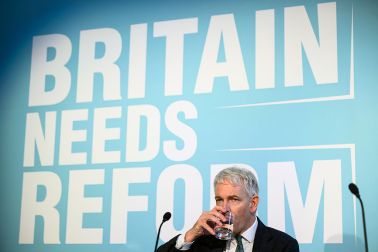At last they have found it. Or, at least, they think they have. Sir Keir Starmer and Kemi Badenoch have been hunting around for months trying to find Nigel Farage’s Achilles’ heel. While they have been searching, the popularity of the Reform party has soared ahead of that of their own parties. But now, finally, they reckon to have identified the weak spot.
In their shared enthusiasm, they both described Reform’s emerging tax plans as ‘fantasy economics’. Starmer gave the bemused workers at a glass factory a seven-minute harangue about it, declaring Reform’s plans a ‘mad experiment’. Badenoch fumed that ‘Jeremy Corbyn’s “magic money tree” is back’ with a Reform sticker on it.
It is true that Reform has been promising tax cuts galore without appearing to offer commensurate spending reductions. So it is legitimate to ask whether they can be afforded. Is there such a thing as ‘Nigenomics’ and, if so, what does it consist of? Is it a good thing or a dangerous gamble?
City firm Panmure Liberum recently put the size of the gap between the spending commitments and the spending cuts – if they were put in place at the same time – at £80 billion a year. Panmure warned that if Reform’s economic policies were carried out, there would be a run on the pound that would be ‘immediate and violent’. A little before that, the Economist called it ‘an agenda of fiscal recklessness that rivals, and may well exceed, the disastrous 49-day, hair-raising, market-tanking premiership of Liz Truss’.
But wait one moment before thinking through the costs and savings. Can we first remember that tax cuts are a good thing? It has been such a long time since anyone produced tax cuts that some people might think they are imaginary, impossible things akin to unicorns and warm Februarys. But they can happen and have done so in the past. Ronald Reagan, the best US president of recent times, delivered them and raised the growth rate of the American economy. So did Margaret Thatcher. The top rate of tax under Labour had been 83 per cent on income from employment and a confiscatory 98 per cent on investment income. She brought both these down to 40 per cent. The standard tax rate fell from 33 per cent to 25 per cent. These and other pro-business, pro-freedom policies led to economic revival to the extent that other countries began to copy Britain instead of pitying it.
Tax cuts provide an incentive to the rich to stay and pay taxes in the UK. They provide incentives to the would-be rich to work more and earn more. They provide incentives to the least well-off to work rather than live on benefits. They incentivise companies to make profits and base their businesses here rather than somewhere else. In these ways, they lead to economic growth and prosperity.
Let’s also remember that there is quite a lot of low-hanging fruit when it comes to reducing spending. One easy win is the plan to fire the civil servants whose sole job is to tell other civil servants to love Diversity, Equality and Inclusion. Reform claims that doing this would save £7 billion. Others question whether the figure is quite that high.
Reform also has no problem with junking £15 billion a year of foreign aid. It has the idea – likely to be widely shared – that countries which spend money on space programmes do not count as the ‘deserving poor’. Naturally, they also aim to stop spending £5 billion a year on free housing for illegal immigrants. If or when Reform stops the boats, the need for housing illegal immigrants will fade away.
Reform has no affection for quangos either. It reckons that it could get rid of at least five per cent of them, which would save another £13 billion. The billions are beginning to add up.
Meanwhile, Reform has some other policies which would be good for growth. It wants to reduce the regulatory burden on business. Reform rightly points to the vast increase in the complexity of our tax rules. The number of pages in Tolley’s Tax Guide, which is meant to make taxes easy to understand for laymen, was already a massive 728 pages 25 years ago. But it has since expanded to 1,020 pages and weighs a hefty 840g. Most people have no idea just how damaging regulations are to economic growth. A couple of American academics calculated, in 2005, that the US economy would have been more than three times its then size if no new government regulations had been introduced since 1949.
There is no great sum of money available for tax cuts. I regret that for Reform to imply that there is, is misleading
Reform’s policy of ditching the net zero target would also be good for growth. British people and businesses pay more for energy than comparable countries across the world. How on earth can British industry – particularly heavy industry – hope to compete when it has to carry this burden? Reform’s policy of ‘drill, baby, drill!’ means we could exploit our own oil and gas instead of continuing to buy it from other countries. That would create employment. Reversing Labour’s high-cost energy policy would also make it easier for the less well-off to keep warm in winter. Fuel costs are a disproportionately big part of the budgets of poorer families. That is not an economic issue, of course. It is a humanitarian one.
Overall, there is a lot to like about these ambitions, which are genuinely pro-growth and would make a great change from Labour’s ersatz growth policies. However, unfortunately it is not all good news.
The cost of the proposal to increase the personal tax allowance to £20,000 is some £50 to £60 billion. The savings listed above come nowhere near financing that tax giveaway. The big saving which Nigel Farage has talked about – and which sounds like it could be on the right scale – is ditching net zero and saving £45 billion. He claims this figure comes from the Institute for Government. But on closer examination, this huge sum is not the current or even the future cost to government of achieving net zero. It appears to be a three-year-old estimate of what the cost would be to individuals and businesses, as well as government, to achieve net zero. In other words, there is no great sum of money available for tax cuts. I regret that for Reform to imply that there is, is misleading. And it gets worse.
Nigel Farage has been strongly in favour of nationalising British Steel. This is a popular position. And yes, in the short term, it will save jobs. You can also argue that Britain has a strategic need to retain some steel-making capacity. But no policy is more doomed to failure than this one. Nigel Farage may be too young to know just how disastrous the previous nationalised British Steel was. He was born in 1964, so he was only 16 when the nightmare of the 1970s came to an end. He may not be aware that in the latter years of its existence, the British taxpayer had to put huge amounts of money into British Steel to stop it going bust. Steel companies compete with each other internationally. They should ideally have one or more comparative advantages. One of the most important is access to cheap fuel. British Steel certainly won’t have that. But it will, in future, have management chosen by British politicians and civil servants. It will have budgets that must be agreed to by British politicians and civil servants. In other words, it doesn’t have a chance in hell.
It seems that Reform is also in favour of re-nationalising the utilities, at least in part. Nigel Farage and his colleagues may not properly remember why the utilities were nationalised in the first place. They were spectacularly inefficient. The electricity-generating companies employed 26,700 people when they were state-owned. Three years after they were privatised, the number of employees had been reduced to only 10,400 – a drop of 61 per cent. Most of the jobs when the companies were state-owned were a waste of taxpayers’ money. In the hands of government, it is inevitable that the cost of all utilities will rise to pay for the non-jobs that will be created. Oh, and there will be strikes.
Nigel Farage’s partiality for nationalisation puts in doubt whether he really understands why capitalism works and socialism doesn’t. Alternatively, it means that he is more interested in gathering votes than concerning himself with the well-being of the economy. Either way, it is not encouraging.
Nigel Farage’s partiality for nationalisation puts in doubt whether he really understands why capitalism works and socialism doesn’t
Nor is his sudden endorsement of cryptocurrencies. You would think that there are more pressing issues, but not for Reform. Suddenly last week we had a detailed plan, complete with a draft parliamentary bill. Reform wants the capital gains tax rate on cryptocurrency profits to be only ten per cent. Why, you might ask, should profits on trading Bitcoin or Ethereum be taxed at less than half the rate an investor would pay on a profit investing in a Midlands engineering company? It makes no sense. Reform even wants the government itself to own cryptocurrencies – things which, in the view of Warren Buffett, the most celebrated investor of our time, are ‘rat-poison squared’. They can certainly be seen as giant Ponzi schemes. Starmer was not wrong in saying that it was appropriate that the policy had been announced by Farage in Las Vegas.
Also worrying is Farage’s sudden announcement last week that he wants to abolish the cap on extra benefits for those who have more than two children. The cap discourages parents from making more children at the expense of other people. There used to be many a family who was interviewed by newspapers boasting that they had eight children and a ninth was on the way – all at the expense of taxpayers.
For a party that claims to be on the side of marriage and work, endorsing the abolition of the two-child cap is strange indeed. The huge number of people of working age living on benefits is one of the biggest financial problems facing the country. But perhaps the new policy is not so strange if you think Nigel Farage is primarily motivated by the ambition to gain power by attracting Labour voters.
When it comes to reducing Britain’s oversized national debt, Reform has had little to say. The debt is currently about 96 per cent of GDP and getting towards crisis level. Back in 2002, it was a mere 29 per cent. Gordon Brown, Boris Johnson and others spent lots of money. But there was no magic money tree. We just borrowed recklessly for two decades. Now our credit is used up. A serious party, if only there was one, would declare a policy of bringing the debt right down again.
Reform’s economic policy has so far been written in a hurry on the back of a beer mat. Insofar as there is a Nigenomics, it has two separate personalities: a Jekyll and Hyde division not untypical of Nigel Farage himself. At times, it is the pure free-market, low-tax, pro-work and family Dr Jekyll who could do this country a great deal of good. But then, at any moment, it turns into a vote-grubbing, unprincipled, spendthrift Mr Hyde. The trouble is, at any given moment, you don’t know which one you are going to get.








Comments